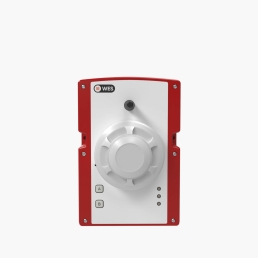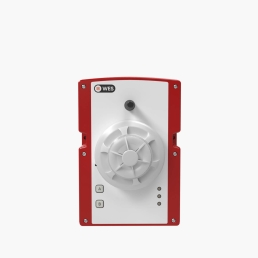Choosing Between Smoke and Heat Detectors in Construction: A Comprehensive Guide
Safety is paramount in the construction industry, and selecting the right fire detection system is a critical decision that can impact the well-being of workers and the security of the site.
Among the various options available, smoke detectors and heat detectors stand out as two primary choices. Understanding their differences, advantages, and suitability for construction environments is essential for making an informed decision.

Smoke Detectors
These devices are designed to identify the presence of smoke particles in the air. They are highly effective in detecting smoldering fires and fires with visible smoke. Smoke detectors are categorised into:
- Ionisation Technology: These detectors use ionisation chambers to detect small particles generated by fast-burning, flaming fires.
- Photoelectric Technology: Utilising light beams, these detectors excel in sensing slow-burning, smouldering fires that produce visible smoke.
Heat Detectors
Unlike smoke detectors, heat detectors respond to changes in temperature rather than the presence of smoke. They are further categorised into:
- Fixed Temperature: These detectors activate when a pre-set temperature threshold is reached, signalling a potential fire.
- Rate-of-Rise: Activating when the temperature rises rapidly, these detectors are effective in scenarios where quick temperature changes precede visible smoke.

Construction Site Considerations
Dust and Debris: Construction sites are dynamic environments with high levels of dust and debris. Smoke detectors may be prone to false alarms in such conditions. Construction sites are notorious for high levels of dust and debris, posing challenges for traditional smoke detectors. To address this, innovative dust-resistant smoke detectors, a distinctive offering from Ramtech, utilise advanced filtration mechanisms to ensure accurate detection amidst dusty environments.
Temperature Variations: Construction sites experience fluctuations in temperature, especially in open-air environments. Heat detectors, including those resistant to environmental factors, can provide reliable performance in varying weather conditions.
Detection Efficiency
Early Detection: Smoke detectors are known for early detection, sensing fires in their incipient stages when smoke is present. This can be crucial for allowing timely intervention and preventing the escalation of fires.
Delayed Activation: Heat detectors, including those resistant to dust, may have a delayed response compared to smoke detectors. They are more effective in scenarios where fires generate heat before visible smoke, such as with certain types of electrical fires.
Placement and Coverage
Optimal Placement: Proper placement of detectors is crucial for their effectiveness. Smoke detectors, especially those designed to resist dust, are generally recommended for areas with potential fire sources, while heat detectors may be suitable for locations where smoke is not the first indicator of a fire.
Comprehensive Coverage: A combination of both dust-resistant smoke and heat detectors may be the most comprehensive approach. Integrating them strategically based on the site’s layout and specific fire risks can enhance overall fire detection capabilities.
Regulatory Compliance
Local Codes and Standards: Construction sites must adhere to local fire safety codes and standards. Understanding and complying with these regulations, along with incorporating advanced dust-resistant smoke detectors, will guide the selection and installation of detectors.
OSHA Guidelines
The Occupational Safety and Health Administration (OSHA) mandates the establishment of effective fire prevention and protection programs in workplaces. Employers are required to identify and control fire hazards, provide firefighting equipment, and establish emergency action plans, ensuring the safety of employees during construction activities.
HSE Guidelines
The Health and Safety Executive (HSE) emphasises the importance of having a suitable and sufficient fire detection and warning system in place. While the specific choice between smoke detectors and heat detectors may depend on the nature of the workplace and the potential fire risks, the key objective is to ensure that the chosen system effectively detects fires at an early stage, allowing for timely evacuation and intervention.
NFPA 241 Standards
NFPA 241, published by the National Fire Protection Association (NFPA), provides specific requirements for safeguarding construction, alteration, and demolition operations against fire hazards. The standard emphasises measures for preventing or minimising fire-related risks during these activities.